Growing okra at home is a great way to add a low maintenance, unique vegetable to your summer garden.
But the first step in learning how to grow okra successfully is understanding what it needs to thrive.
In this guide you’ll find all the details you need, including water, light, soil, and fertilizer requirements, plus extra tips on pests, pruning, harvesting, and more.
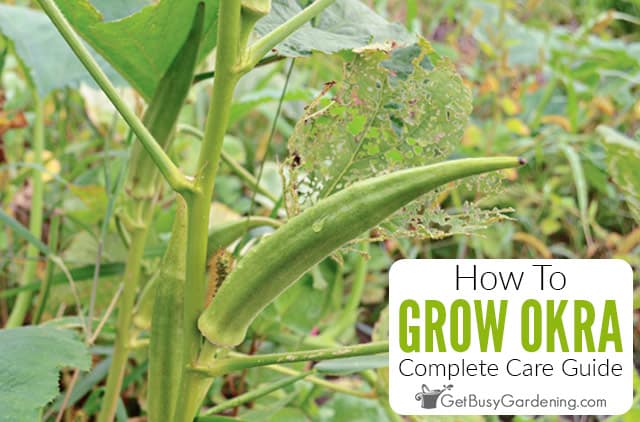
Quick Okra Care Overview
| Scientific name: | Abelmoschus esculentus |
| Classification: | Vegetable |
| Common names: | Okra, Lady Finger, Gumbo |
| Hardiness: | Zones 10-12 |
| Temperature: | 70-85°F (21-29.4°C) |
| Flowers: | White to yellow, blooms summer-fall |
| Light: | Full sun |
| Water: | Allow soil to dry between waterings, do not overwater |
| Humidity: | Average |
| Fertilizer: | Balanced organic liquid or granular fertilizer, once a month spring-summer |
| Soil: | Well-draining, fertile, loamy |
| Common pests: | Aphids, root knot nematodes, flea beetles |
Information About Okra
Okra (Abelmoschus esculentus) is a member of the Malvaceae family that also includes cotton, holly hocks, and hibiscus. It’s an easy to grow warm weather vegetable originally from Africa.
It has a single main stem, thin branches, and large leaves. The plants range in size from 3-8’ tall, and produce edible seed pods from either yellow or white flowers that are similar in appearance to a hibiscus.
The entire plant, including the pods on many varieties, is covered with small, spiny hairs that can cause skin irritation.
The pods are edible when tender and young, and traditionally used for thickening stews or gumbos, earning it the nickname ‘Gumbo’.
Different Types Of Okra
There are many different varieties of okra to choose from. They are typically green or red, and range in overall size and days to maturity.
Many gardeners opt for a spineless variety, which feature pods without the spiky hairs. Thankfully no matter which type you choose, they can all be cared for in the same way.
- Clemson Spineless – The flavorful pods on this 4’ variety have no spikes and mature in 60 days.
- Burgundy – This deep red variety averages about 4’ tall and is known for being an abundant producer after about 60 days.
- Jambalaya – This compact variety is great for northern climates and produces green, flavorful pods in just 50 days.
- Cajun Jewel – A dwarf okra plant averaging 2.5 – 4’ tall that matures in just 50-55 days, making it ideal for containers and shorter growing zones.
Hardiness
Okra is a perennial vegetable that will grow year around in warm climates where there are no frosts or freezes.
It’s hardy year-round in zones 10-12 where the winters are mild, however it’s grown as an annual in most regions.
How Does Okra Grow?
Edible okra pods grow from the fairly large self-pollinating flowers that begin to appear in mid-summer.
The blossoms have both male and female parts and will produce pods without the assistance of pollinators in 3-4 days, as long as growing conditions are ideal.
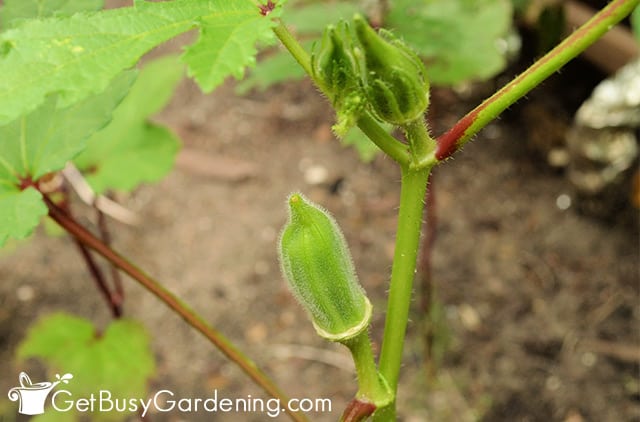
How To Grow Okra
Before we get into the specific care needs, first let’s chat about where and when to grow okra. Choose the right time and location to help your plants produce at their very best.
Where To Grow Okra
Okra grows best in a location that gets plenty of direct sun. They do great either in the ground or in large containers that have good drainage.
Some varieties can get very tall. So choose a space or a pot that can accommodate the mature size without it becoming confined or crowding neighboring plants.
When To Plant Okra
Okra is a heat and sun loving plant. It will not grow in temperatures less than 60°F (15.5°C), so don’t try to plant it early.
Instead, wait until all chance of frost has passed in the spring and the soil temperature is about 65°F (18°C) or above. You can check that with a probe thermometer.
If you live in a cool climate, start okra indoors 2-4 weeks before the last frost. Choose a biodegradable pot that will allow you to plant them directly without disturbing the delicate taproots.
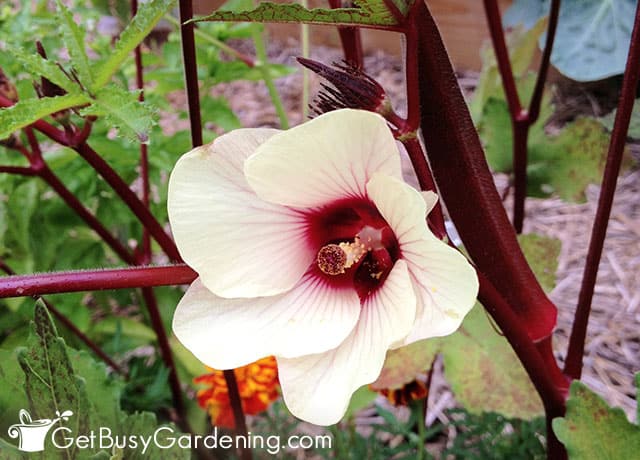
Okra Plant Care & Growing Instructions
Now that you know where and when to plant it, it’s time to talk about how to grow okra at home. The care tips here will help you create an ideal growing environment for them to thrive.
Sunlight
Okra needs full, direct sunlight to grow its best. Choose an area in the garden that will receive as much sun as possible throughout the day, uninhibited by shade.
As they grow tall, okra plants can start to cast shadows over each other. So space them according to the anticipated final size. Too much shade will reduce flowering, as well as pod production and growth.
Water
Okra is one of the more drought tolerant vegetables. It doesn’t like wet feet and can handle some periods of dryness.
But too little water can lead to wilting and stunted growth, especially when the plant begins producing flowers and pods. Provide 1” weekly, then let it dry out slightly between drinks.
Temperature
Heat is your friend when growing okra. It prefers temperatures in the range of 70-85°F (21-29.4°C).
The plants can even tolerate extreme highs of 100°F (37.7°C), but extended hot periods will require more frequent water.
Anything cooler than 60°F (15.5°C) can stunt or stall growth, and any type of frosts or freezes will quickly kill the plant.
Fertilizer
Abelmoschus esculentus is not a heavy feeder, but it benefits from the occasional application of fertilizer throughout the growing season.
Choose balanced, organic fertilizers in either granular or liquid forms. Apply slow-release granules once in the spring and summer, or liquids up to once a month.
Compost tea and fish emulsion are both good natural liquid options, or you can use organic flowering vegetable granules.
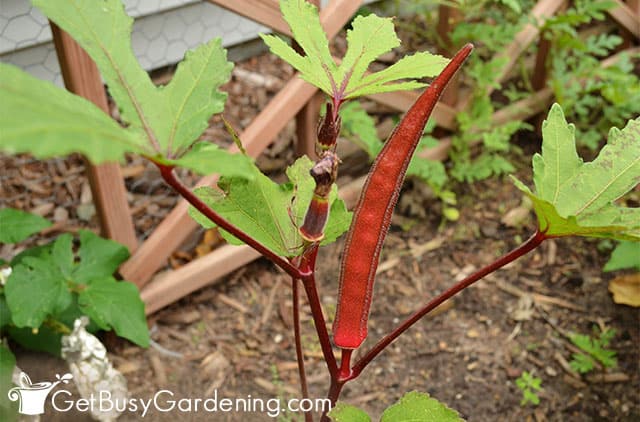
Soil
Okra isn’t too picky about soil. But the ideal blend is well-draining, loamy, and fertile, with a pH ranging between 6.0-8.0, which you can test with a probe gauge.
Amend garden soil with well-aged manure or compost at planting time to improve nutrient values and drainage, and get your plants off to a right start.
Pruning
There’s no real need to prune okra, especially if you’re growing it as an annual. But a few trims throughout the season makes harvesting easier.
Always use sterile, sharp pruners and wear long-sleeves and gloves to protect your skin from the prickly plant.
Okra pods develop at the bottom first, then steadily move up the plant. Cut back the top when the plant reaches 5-6’ tall to keep pods within easy reach and to encourage bushier growth.
At the end of the summer, prune back the top 2’ of leaves to re-invigorate it and encourage a final crop to form.
Pest Control Tips
Okra is not prone to many pest problems, but they can happen. Aphids, root knot nematodes, and flea beetles are a few of the most common ones.
Sharp blasts of water, beneficial insects, neem oil, and insecticidal soap are all effective measures against aphids and small bugs. I make my own spray by mixing 1 teaspoon of gentle liquid soap with 1 liter of water.
Root knot nematodes can cause swollen roots and stunted growth. There are measures you can take, such as heating or increasing organic matter in the soil to reduce their numbers, but only before planting.
Disease Control Tips
Healthy okra plants are usually fairly problem free, but they can fall victim to downy mildew and fusarium wilt.
Mildew will appear as white spots or patches on the leaves. Water at the base of the plant, maintain good airflow, and apply organic fungicide to prevent or stop it from spreading.
Wilt is a soil borne disease that will eventually kill the plant. Affected plants should be removed and destroyed (not in your compost bin), to prevent it from spreading through the garden.
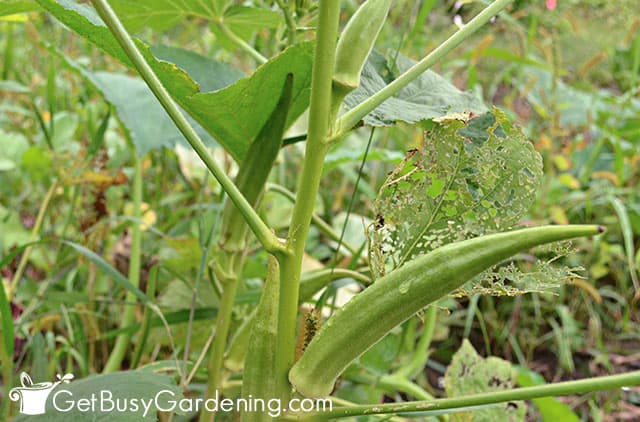
Tips For Harvesting Okra
The best time to harvest is when the pods are young and tender, ideally between 2-4” long. They will become stringy and tough if you let them grow much larger.
Use sharp, sterile micro snips or precision pruners to clip the okra off the stem just above the pod cap.
Okra is a plant that benefits from continual harvesting. The more you pick, the more it will produce. They develop in as little as 2-3 days after flowers appear, so check back frequently.
Related Post: Easy Baked Okra Fries Recipe (Oven Or Air-Fryer)
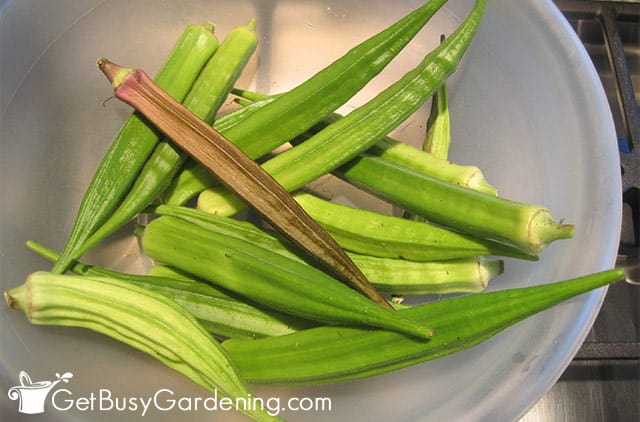
Troubleshooting Common Problems
Okra is typically fairly easy to grow, but no plant is completely problem free. If you run into one of these more common issues, my tips below can help you manage it.
Yellow Leaves
Yellowing okra leaves can be caused by watering inconsistencies, disease, pests, and weather fluctuations.
They’re drought tolerant, but will suffer from either extreme dryness or wetness.
Instead, aim to water deeply 1” per week and allow them to dry just a little between drinks. A moisture gauge can help you if you have trouble.
Treat pests as you see them and look for signs of disease. Providing protection from cool dips or extreme heat can help your okra tolerate dramatic temperature changes without major consequences.
Slow Growing Okra Plant
The most common cause for a slow growing okra plant is the temperature. It will not grow well in anything below 60°F (15°C), and really prefers something warmer.
It may also be a matter of patience. Okra is slow to grow at the beginning of the season, and takes off toward mid to late summer when the heat kicks in.
Wilting Leaves
Wilting leaves on your okra plant are likely caused by fusarium wilt, overwatering, or drought. This plant doesn’t tolerate wet feet or extended periods of bone-dry soil.
If half the plant is wilting and yellowing, you may be dealing with disease. Dig up and destroy the plant before it can spread to your other vegetables.
Brown Leaves
Brown leaves, spots, or tips are usually caused by disease, improper watering, nutrient deficiencies, or cool weather.
Wait to plant until nighttime temperatures stay above 60°F(15°C) and protect plants with row covers if unexpected cool weather occurs.
Amend soil with plenty of compost, and water regularly so the soil is saturated but not soggy, then allow it to dry.
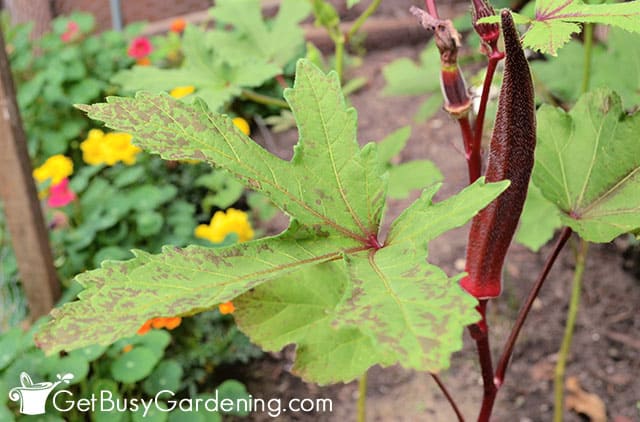
FAQs
Here I’ve answered some of the most commonly asked questions about growing okra. If yours isn’t listed, please add it to the comments section below.
Is okra easy to grow?
Okra is easy to grow because it tolerates mild drought and poor soils, as long as it has plenty of sun and temperatures higher than 70°F (21°C).
How long does it take for okra to grow?
How long it takes okra to grow varies depending on the type, but most varieties average between 50-65 days to reach maturity and be ready to harvest.
Does okra come back every year?
Okra is a perennial that can come back every year in regions that have mild, warm, frost-free winters, such as in growing zones 10-12.
What is the secret to growing okra?
The secret to growing okra is proper planting time and location. Wait until temperatures are higher than 60°F(15°C) at night, and plant it in fertile, neutral soil where it will receive plenty of direct sun.
Do okra plants need support?
No, okra plants do not need a cage, trellis, stake, or any other kind of support to grow. If yours becomes tall and leggy, then cut back the top to encourage bushier more compact growth.
If you’d like to learn how to make the most of your space and get as much homegrown food as possible, then my Vertical Vegetables book is perfect! It will teach you all you need to know, has tons of gorgeous photos, and includes 23 DIY projects you can build for your own garden. Order your copy today!
Learn more about my Vertical Vegetables book here.
More About Vegetable Gardening
Share your tips for growing okra in the comments section below.
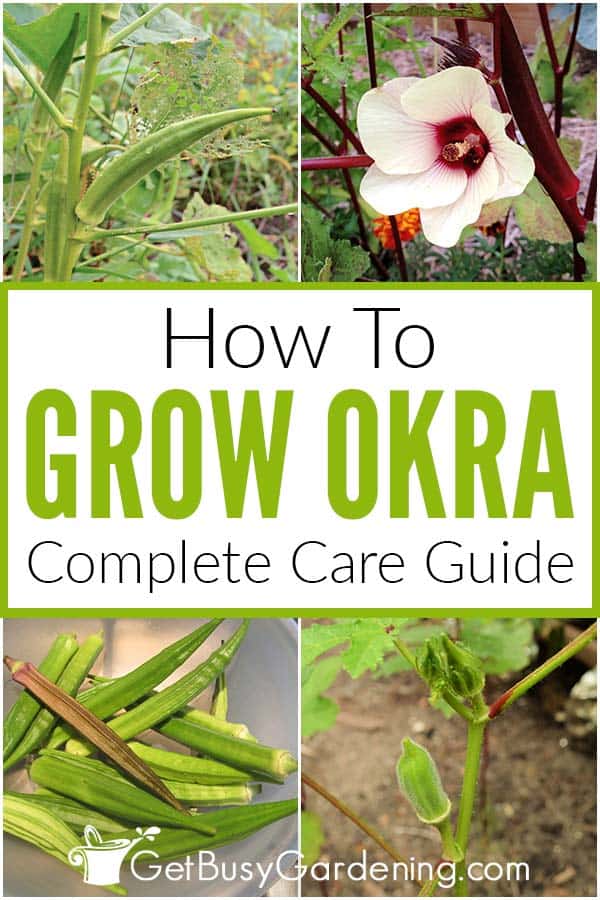

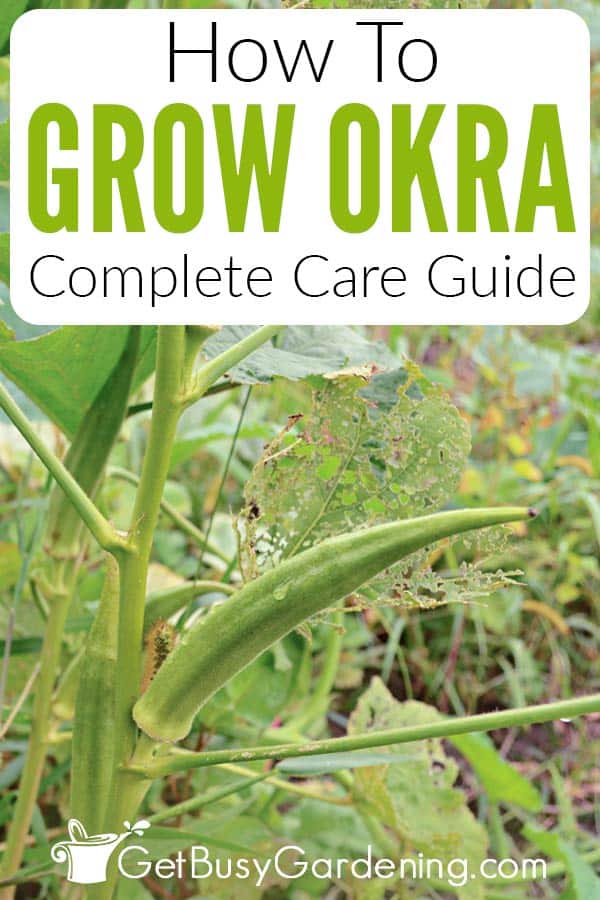


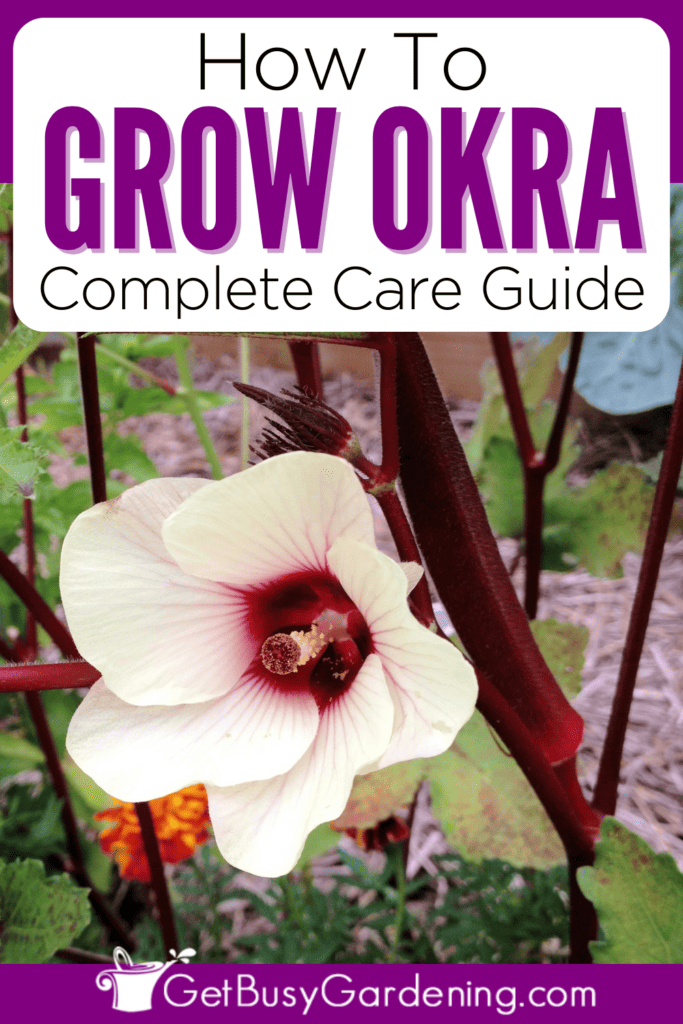

Leave a Reply